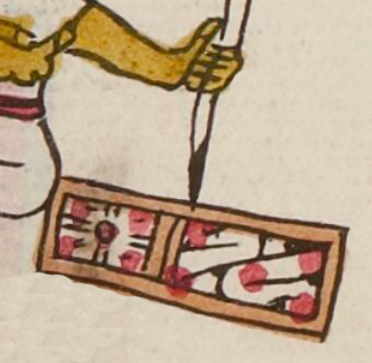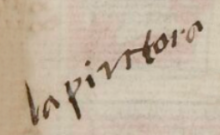tlacuiloliztli (TR30r)
This iconographic example showing a woman's hand and a writing implement over a piece of writing or a painting (seemingly featuring a compound glyph with two signs, but with no explanatory gloss that would help the viewer understand it) seem to represent the act of writing or painting (tlacuiloliztli). It is found in the Codex Telleriano-Remensis. The piece the woman is creating is a long rectangle with a light brown perimeter. This trim also divides the rectangle in half. It could be a manuscript that would have been screen-folded. On the left half is a quincunx, a flower-like shape. Elsewhere in this collection, this shape represents the term tonalli (day). On the right are two volutes that are reversed, back to back. They are much like the volutes associated with speech scrolls, and they have been interpreted to mean ilhuitl (also day, stemming from a near homophone for ilhuia, to say to someone). The volutes have dots around them, which might be interpreted as vibrance (tonalli) and/or the cardinal directions. The designs on both halves are red and white.
Given the museum photo (below) of a very similar (perhaps compound) glyph, circling around a stone several times, suggests a diphrasism--perhaps for writing and painting a tonalamatl (annals, or a sacred day-by-day accounting). This complements what some scholars (such as Jeanette Peterson, 1993, 47–49) identify as an ilhuitl (day) in the sign of opposing volutes (for ilhuia, the near homophone). The flower-like shape is strikingly similar to the flower shape in the compound glyph for Atonal, where this shape stands for tonalli (also meaning day). So, while the diphrase may refer to painting and writing, it also provides two signs for day, making a strong link to the tonalpohualli, count of the days (a religious divinatory calendar).
Stephanie Wood
See (below) the glyph for what we also presume to be a tlacuiloliztli from the Codex Mendoza (folio 70 recto) for comparison with the right-hand symbol on this glyph. And see the glyph for Cuilol from the Matrícula de Huexotzinco (MH) for a symbol much like the one on the left-hand side of this glyph. If that is a cuilolli (a piece of writing, a painting, or something with a design), then the piece of writing featured here could be a tlacuilolli, but the lack of a gloss leaves this inconclusive. The MH glyph for the personal name or occupation Tetlacuilo has swirls instead of scrolls per se.
Elizabeth Hill Boone calls the enclosed scrolls of this record an ideogram for the "tonalamatl or sacred almanac of the days." She equates the symbol with "day," while also admitting that it does not bear a resemblance to a day, but the association is "culturally assigned." She puts this sign on an equal footing with the tonalli signs on folios 7v and 19r of the Codex Mendoza. [See: Stories in Red and Black, 2000, 35.] James Maffie states that the left-hand stone of the Piedras de los Reyes monument "depicts Cipactonal working on what one would think is a tonalamatl, supporting the interpretation of ilhuitl double opposing speech scrolls within a rectangular box as tonalamatl." He also notes how "Mikulska distinguishes the meaning of two opposing speech scrolls from two opposing speech scrolls within a rectangular box." (Personal communication, 1/12/2023.)
Marc Thouvenot (2010, 184–185) identifies the boxed opposing speech scrolls in the Codex Mendoza as "ilhuia", adding that a subset of things having to do with writing (tlacuilolli) are associated with language (not just mainly images or visual things). But he also identifies the same sign of opposing speech scrolls in the Codex Xolotl as cemilhuitzin. There, it has an added sign which seems to contribute to it being seen as "a day" (in the reverential) which brings us back to the book of the days. But, Cemilhuitzin was also a person (hence the reverential), a "traitorous relative" of Nezahualcoyotl (according to Jerome Offner, 2016, 107), and one of the authors of a text of Chichimec history that relates to the Codex Xolotl, according to José Rabasa (2016, 180), found in studies published in Galen Brokaw and Jongsoo Lee, ed., Fernando de Alva Ixtlilxochitl and His Legacy (2016). However, it is not clear how that personage would be relevant to the understanding of this glyph.
In a personal communication James Maffie adds further: "Mikulska and Whittaker defend the existence of a link between ilhuitl and ilhuia not on the basis of their shared meaning but rather on the basis of the shared sound of the words “ilhuitl” and “ilhuia.” [Note: Mikulska, Tejiendo destinos, 2015, 51.] Gordon Whittaker describes the ilhuitl glyph “with its embedded, interacting speech scrolls for phonetic ilhui (from ilhuia “say [to someone].” [Note: The use of bolding is by Whittaker. See his Deciphering Aztec Hieroglyphs, 2021, 98.]
See below for other glyphs with a clearer connection to tlacuilo, tlacuilolli, and cuilolli, among others, which may offer support for the choice of tlacuiloliztli for this glyph. The combination of two signs that mean "day" suggest that writing was primarily thought of as the writing/painting of annals.
Stephanie Wood
la pintora
Stephanie Wood
ca. 1550–1563
Stephanie Wood
writing, escritura, escritos, escribanos, tlacuilos, tlacuiloqueh, mujeres, género, tlacuilolli, cuilolli, tlacuilo, ilhuitl, tonalamatl
This stone carving of what appears to be a pair of glyphs that refer to writing and painting (but might alternatively refer to the sun and a day, ilhuitl) is located in the Museo de Escultura Mexica at the archaeological site of Santa Cecilia Acatitlan (juris. Tlalnepantla, Mexico City). This visual diphrasism repeats around what was a cuauhxicalli (container for hearts) that was repurposed as a baptismal font, according to the interpretation in the museum. Photo by Stephanie Wood, 13 August 2023.

tlacuiloliz(tl), the act of painting or writing, https://nahuatl.wired-humanities.org/content/tlacuiloliztli
Telleriano-Remensis Codex, folio 30 recto, MS Mexicain 385, Gallica digital collection, https://gallica.bnf.fr/ark:/12148/btv1b8458267s/f85.item.zoom
The non-commercial reuse of images from the Bibliothèque nationale de France is free as long as the user is in compliance with the legislation in force and provides the citation: “Source gallica.bnf.fr / Bibliothèque nationale de France” or “Source gallica.bnf.fr / BnF.”










